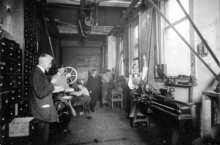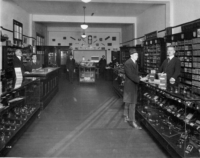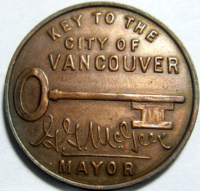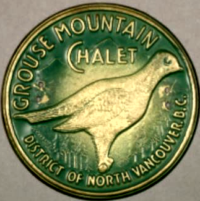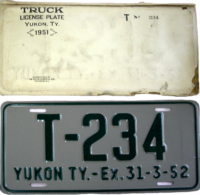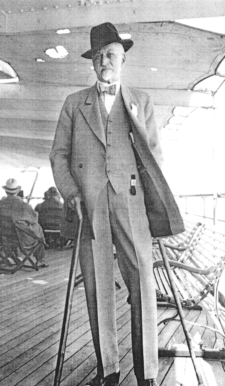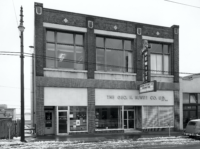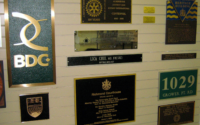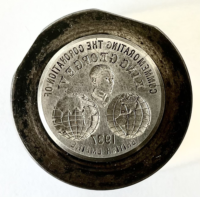Geo. H. Hewitt Co. (Chicago)
1885-1898
In 1879 George living in Toronto, Ontario, Canada was researching on and experimenting with the revolutionary technology of vulcanized rubber stamp products which were changing the publishing and advertising industries of the time. In 1884 at the age of 22, George moved to 167 Washington Street, Chicago, Illinois, U.S.A to research and experiment further as Chicago was considered to be the advertising and publishing capital of North America at that time and in 1885 George created his own Company, The Geo. H. Hewitt Co. (Chicago).
To compliment his business, George also negotiated to sell other manufacturer’s products in addition to his own creations operating as a “Branch Store” which he did for both S. H. Sheplar & Co. located at 702 Market Street in San Francisco, California and The Los Angeles Rubber Stamp Company (LARSCO) located at No. 20 North Spring Road in Los Angeles, California. These two Companies were the largest rubber stamp and related products manufacturers on the Pacific Coast at the time. From his office in Chicago, George travelled to locations in the United States and Canada advertising and selling rubber stamp and related products.
Below are pictured George’s two original creations which he patented in 1892. “The Hewitt Press” and “The Hewitt Printing Wheel”.
Geo. H. Hewitt Co.
1898-1900
In 1898 George followed the Klondike Gold Rush route, travelling as far as and setting up a second Company in Vancouver, Canada.
George set up a small office and manufacturing area located at 720 Granville Street, hired employees and purchased equipment in order to manufacture “Fine Red Rubber Stamps”, brass stencils and desk seals.
At this time, George maintained his Company in Chicago, USA at 187 Washington Street as well as continuing to operate as a branch store for LARSCO. George travelled throughout B.C. promoting his Company and exhibiting his various products.
Geo. H. Hewitt Co.
1900-1912
In 1900 George moved to The Fairfield Building located at 445 Granville Street, Vancouver occupying unit No. 9 from 1900 to 1905 and enlarging his business to also include unit No. 10 from 1906 to 1912. During this time, George maintained his Company in Chicago, USA at 167 Washington Street, remained a branch store for LARSCO and was now advertising in news papers in major Cities throughout North America with PO Box 446 Vancouver, Canada and PO Box 512 Seattle, USA.
New equipment was purchased and manufacturing increased of products such as “The Hewitt Press”, “The Hewitt Printing Wheel”, “Superior Rubber Stamps”, brass stencils, desk seals as well as brass and other types of “High Grade Metal Signs”, metal plates and badges, numbering machines and the many other items.
Our first phone number was B. 2683 in 1907, which changed to L. 3663 in 1909.
Geo. H. Hewitt Co. Limited
1912-1916
In 1912 the Company moved to 564 Richards Street, Vancouver.
Additional modern engraving, punching, printing and related equipment was purchased as well as hiring additional experienced engravers and die sinkers to expand our capabilities and products offered for sale.
On February 21st, 1912 we received our Certificate of Incorporation from The Province of British Columbia and became The Geo. H. Hewitt Co. Limited. George closed his Company in Chicago, ended his branch store agreement with LARSCO and now focused on one business at one location.
Additional products now being manufactured from this location included metal stamps, formed metal badges, key tags, etched metal name plates and metal lettering.
In 1912 our phone number became SEYmour. 5844
Geo. H. Hewitt Co. Limited
1916-1921
In 1916 the Company moved to 576 Richards Street, Vancouver.
The Company purchased and installed a stationary hit & miss engine, overhead shafts, pulley’s and belts to power and operate additionally purchased modern equipment allowing us to bid on and be awarded contracts with Government, Cities and Corporations for large quantities of products which we were now manufacturing such as municipal and other types of metal licence plates, emblems, ship identification plates and other specialty metal products.
We now also provided the various forestry sectors of BC with many of our different marking devices and supplies such as log hammers, shingle brands, brass stencils, etc.
Geo. H. Hewitt Co. Limited
1921-1925
In 1921 the Company moved to 653 Seymour Street, Vancouver.
The Company purchased a large mechanical press which was used to increase our manufacturing capability for producing larger types of license plates and pressed metal products.
Our skilled artists and hand engravers were creating the highest quality tooling available at the time used to manufacture logo stamps, press plates and metal tooling.
Geo. H. Hewitt Co. Limited
1925-1930
In 1925 the Company moved to 592 Seymour Street, Vancouver.
The Company required this larger building due to the purchase of additional presses and related equipment required to manufacture the number of large orders being received for punched and stamped metal products. Some of the products being designed and sold included the 1928 and 1929 Canada National Parks buffalo park passes, advertising and commemorative token’s, chauffeur, inspector, security and other badges, vehicle and bus emblems, license plates for vehicles, bicycles, and motorcycles and pet tags.
These products were being punched, pressed and finished in stainless steel, brass, aluminum, copper and “German Silver” which was primarily used for badges. These products were in addition to the hundreds of various marking devices which we were regularly manufacturing and supplying.
In only a few short years at this location it became apparent that space was again an issue. Plans were underway to design and build a new custom facility that would fit our needs perfectly and allow the Company to grow into the future.
In 1929 SEYmour. 5845 was added as a second phone line.
Geo. H. Hewitt Co. Limited
1930-1962
In 1930 the Company moved to 732 Homer Street, Vancouver.
Construction of this custom designed building began in early 1929.
License plates were still a very requested item and we continued to design and manufacture license plates for many different uses such as “Express & Dray”, Junk Peddlers”, “Huckster”, “Motor Vehicle”, “Truck”, “Taxi Cab”, “Commercial” “Motorcycle”, “Bicycle” and other applications. Licence toppers and radiator emblems were also designed and made for such uses as the National Parks of Canada, The Grouse Mountain Highway, BCAA, The Armed Forces of Canada as well as for car sales dealerships and other uses.
The requirement of punched and stamped metal products continued to grow until Canada entered into World War II in September, 1939. By 1941 metal for the war effort created a shortage whereby it became increasingly harder to acquire it for manufacturing purposes except for Government approved and deemed essential items which we had been granted authority to manufacture.
We researched and manufactured many alternative metal products during this time. Vulcanized paper fiber board was used as an alternative for punched and stamped badges. An example is to the left (1943 B.C. Chauffeurs badge). Celluloid pin-back buttons which we had been manufacturing for some time were now manufactured as an alternative to many other types of full metal badges. Linseed oil saturated, vulcanized and cured paper fiber was used as an alternative to brass for the manufacturing of stencils. Bakelite and other plastics, woods and rubber were used as alternatives to metal in seals, nameplates and signage manufacturing.
We maintained our highly skilled “Die Sinkers and Engravers” who were artisans qualified in the designing, modelling and striking of medals, coins and specialised metal products during this time due to the fact that we manufactured many “essential” metal products for governments.
By 1944 metal was once again readily available and we were able to increase the manufacturing of many metal products that were requested.
We designed and manufactured a great deal of custom products for customers over the years. One notable design was the gold panner logo licence plate which we manufactured for the Yukon Territory and which was introduced and advertised in 1952 for release the following year.
We had been making licence plates in one form or another since the early 1900’s and that work continued until 1957 when we were approached by and ultimately sold many of our contracts and some of our dedicated equipment, dies and tooling for making license plates of all kinds to The BC Government who moved the equipment and work to Oakalla Prison to compliment the work being done there since 1932. We continued manufacturing a few commercial vehicle and other licence plates for various cities until 1968 when we discontinued in-house license plate manufacturing.
In 1930 our phone number was TRinity 4291. In 1941 our phone number became PAcific 6148 and in 1956 it became MUtual 1-6148.
Geo. H. Hewitt Co. Limited
1962-1994
In 1962 the Company moved to 944 Richards Street, Vancouver V6B 3C3
A number of outdoor sales representatives were hired to promote our existing business and search for and bring in new sources of business for the Company to manufacture. Rubber stamps, desk seals, stencils and related products were doing well but we were experiencing a decline for punched and stamped metal products due to high metal and manufacturing costs causing a decline in orders except from Cities, Governments and large Corporations who were still regular customers. By this time we had already successfully changed many of our customers over to less expensive options for punched and stamped metal products and those product were selling well.
Our metal manufacturing equipment was sitting idle and ready for work so we created tooling for and promoted custom stamped and sequentially numbered annual metal dog tags. These were available in aluminum, stainless steel or brass and we began receiving orders from local Governments and associations across Canada.
Supplying products to the forestry sector since 1915, we worked with them to investigate if we could manufacture and supply additional products for them. This led to dozens of new and improved products including various types of grading ink, aerosols, grade printing equipment, ink rolls, ink pads, stencils, chalk, crayons, tree and log marking paint, etc. The Company purchased additional large modern vulcanizing and lead type casting equipment, created proprietary formulations of natural and synthetic rubbers, created and licensed our “Hewco” trademark for these products and greatly increased the manufacturing and quality of our deep type rubber grade stamps and dies. These stamps and dies are custom made to order for any and all equipment or can be mounted to custom high quality hand, roller, self-inking and hammer mount applications.
“The House of Letters” nickname was given to us by our many customers. Over a million available in-stock in sizes from 1/4 to 12 inches high! Available in plastic, ceramic or our own Polycast”. Architectural dimensional letters became a very successful part of the business prior to the invention of computers and CNC cutting systems and we invested heavily into stocking them for quick availability. We also offered the availability of custom vacuum formed plastic, cast bronze, brass and aluminum or moulded plexiglass and wood cut-out letters. Property and building managers, construction companies, school districts, governments and other customers were in our showroom regularly working with our design and sales employees to order and receive the letters they required for various projects and needs.
Custom cast bronze and aluminum plaques were designed and set on-site ready for casting. “Rubberline” changeable directory and bulletin boards were made to order. “Welletter” individual thermal kiss-cut vinyl letters were ready and available as needed. A complete silk screen printing department was created for manufacturing decals and screen printed onto metal and plastic name badges, name plates and for creating graphics for celluloid pin-backs. Custom hot stamped key tags, coat checks, hat checks, convention badges, locker tags and award ribbons were available for hotel’s, motels and the hospitality sector. A full repair and maintenance department was available for all of the mechanical items we sold and we also offered signage installation.
In 1966 our phone number became 682-5861 and our first telex number was 04-507561.
Geo. H. Hewitt Co. Limited
1994 - 2019
In 1994 the Company moved to 2055 Boundary Road, Vancouver V5M 3Z1
By the late 1980’s the introduction of computers had just begun to influence our departments but over the next two decades many changes were realised to our processes, equipment and how employees worked. Our old reliable equipment, some pieces purchased as early as 1900 and retrofitted over the years with electric motors continued to be used but new innovations were quickly making some of this equipment antiquated. For office rubber stamps, newly purchased computer controlled design and cutting equipment allowed for much quicker manufacturing times and did away with hours of type setting, casting and cutting by hand compared to the time needed to perform the same work with computerized equipment. A single employee easily operated two or more pieces of this new equipment at the same time seated at a desk while also typesetting at a computer station.
The internet changed things further as customers could now search for and buy products without ever speaking to a sales person and without regard to where these products were being made. This changed both the practice of buying locally and the reliability and quality of products. Inexpensive, mass produced and poor quality products were being made in other countries and were readily available for purchase on the internet. For many customers price was the driving factor determining their purchase as quality took a back seat and was barely being considered in their decision.
We adapted our prices and competed as hard as we were able but we never cut corners when it came to quality. Quality built our reputation and we were determined to keep it. Some customers we lost due to price but often our quality won them back after they bought and used a product they had purchased online from somewhere else.
Much of our old equipment, tooling, type cabinets and accessories were offered to and taken by schools, individuals and local museums or were scrapped due to the size and weight of some pieces. Some equipment and items remained on display and some equipment remained operational and continued to be used along side modern equipment.
We discontinued past popular products which were no longer competitive or no longer sought due to modern alternatives. Over time our staffing levels were reduced as employees who retired were not replaced and this allowed us to become as efficient and cost effective as possible. We became the best we could be, specializing in the products we sold while keeping the successful old ways of operating a business intact and we thrived on this model.
In 1994 our phone number became 604-294-6288 and our fax number was 604-294-5401.
Geo. H. Hewitt Co. Limited
2019 - Present
In 2019 we moved to Unit 2125 – 575 Seaborne Avenue, Port Coquitlam. V3B 0M3
Our new 10,000 square foot state of the art facility was custom built to our specifications and is situated along the West bank of the Pitt River, North of Lougheed Highway in the Seaborne Park industrial area of Port Coquitlam.
We remain a small family owned and operated Canadian business. Our current workforce of 12 employees represents over 200 years of combined direct experience in this Company and the many products we manufacture and supply. We can solve any marking puzzle you may be having and we stand behind everything we sell.
Rubber stamps and Forestry products remain our top selling items. Signage, Name Badges, Branding Irons and Corporate & Notary Seals are also very popular.
In January 2021 we re-tooled our Engraving Department with new machinery and improved the process of manufacturing many of our existing engraved products such as branding irons, wax seals, leather and other types of brass stamps. In October 2022 we introduced UV direct printing and improved our Bead Braille capabilities in our Signage Department to better serve the Signage market moving forward.
We have a very long history and we have a very good reputation. We are determined to continue with both long into the future!
1937 medallion commemorating the coronation of King George VI. This medallion was made for the B.C. Government who provided them to dignitaries at their discretion. The medallion above was donated by Don and Betty McDougall in March, 2023. Don believes that this medallion came from the parents of his Mother, Phyllis. Godfrey and Nellie Vigne immigrated from England to Creston, B.C. They were befriended by Colonel Edward Mallandaine, the founder of the town and the boy pictured in “The Last Spike” photograph in this link. www.mallandain.com/edward.ramsay.htm. Don suspects Colonel Edward Mallandaine received the medallion from a member of the B.C Legislature given his status as Mayor at the time when King George VI was coronated.
Geo. H. Hewitt Co. Limited
Artifacts of The Geo. H. Hewitt Co. Limited
Occasionally we are contacted by an individual who has either come across an item or inherited an item bearing our Company name. It was and still is standard practice to mark items which we manufacture with our information. As the Company is 125 years old it is not uncommon for an artifact to be identified as manufactured by us and equally not uncommon for the owner of an artifact to find us with a simple online search of our name.
When contacted regarding an artifact it is interesting to hear or read the story of how an individual came across that artifact and in many cases it is equally interesting to discover that information regarding the artifact is not presently known. Many items we manufactured were small limited and custom manufacturing runs for business, government and corporations. Most of these items that someone is researching through us are at least 50 years old. Often there is a die or piece of paperwork remaining which can place the artifact but sometimes there is not and in these cases it is exciting to try and place exactly when and for what reason the artifact was created.
To the left are images of artifacts we were contacted about or graciously provided with and if available an image of the manufacturing die used to make it. We welcome you contacting us if interested in what we may be able to offer in regards to information concerning the artifact in your possession.














